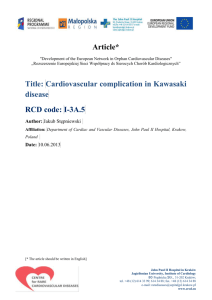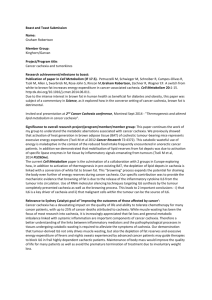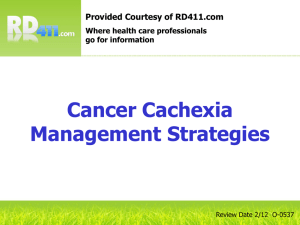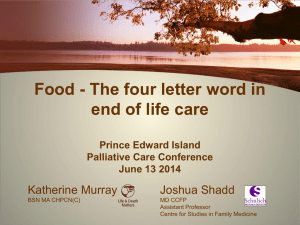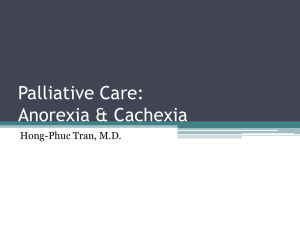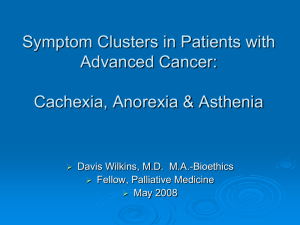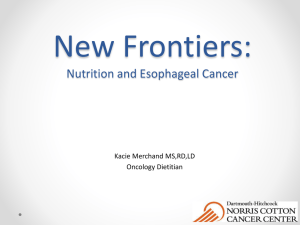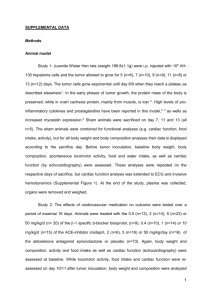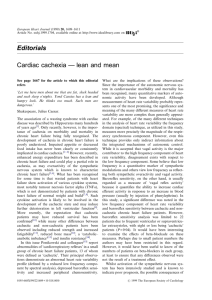Dear Colleagues, - Centre for Rare Cardiovascular Diseases
advertisement
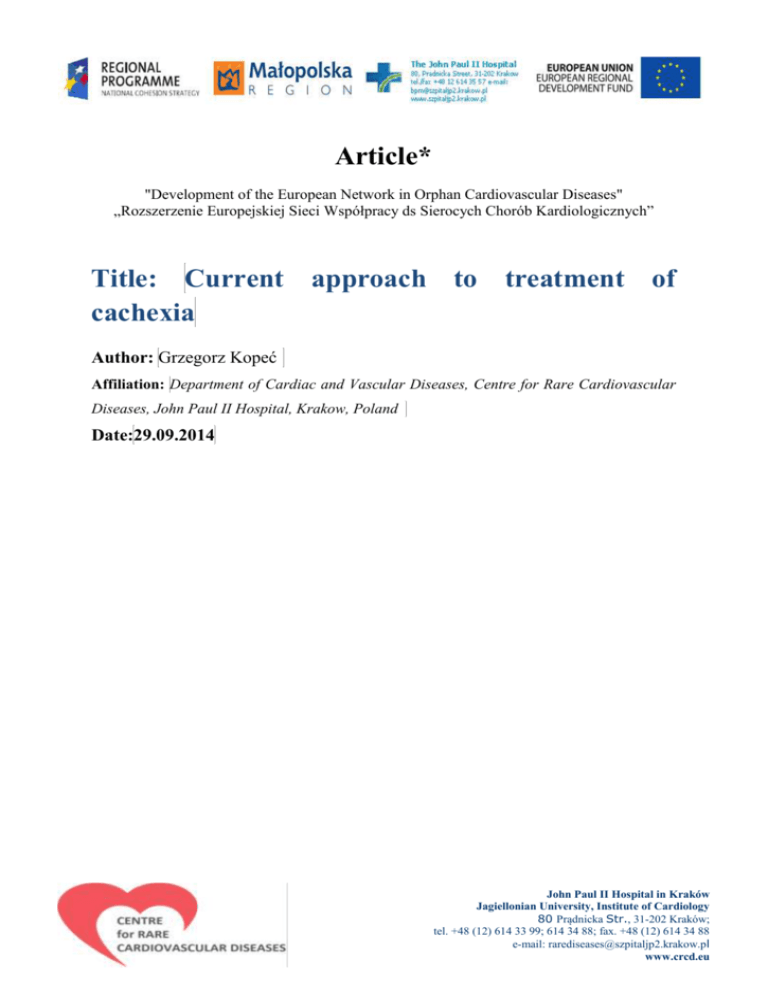
Article* "Development of the European Network in Orphan Cardiovascular Diseases" „Rozszerzenie Europejskiej Sieci Współpracy ds Sierocych Chorób Kardiologicznych” Title: Current approach to treatment of cachexia Author: Grzegorz Kopeć Affiliation: Department of Cardiac and Vascular Diseases, Centre for Rare Cardiovascular Diseases, John Paul II Hospital, Krakow, Poland Date:29.09.2014 John Paul II Hospital in Kraków Jagiellonian University, Institute of Cardiology 80 Prądnicka Str., 31-202 Kraków; tel. +48 (12) 614 33 99; 614 34 88; fax. +48 (12) 614 34 88 e-mail: rarediseases@szpitaljp2.krakow.pl www.crcd.eu Cachexia can be diagnosed when there is loss of more than 5% of body weight over 12 months or less in the presence of a chronic illness such as heart failure, chronic obstructive pulmonary disease, chronic kidney disease, or cancer. This condition remains a great challenge in clinical practice and is associated with impaired survival. Current treatment options include: 1. appetite stimulants 2. antiinflammatory drugs 3. ghrelin 4. anabolics Overexpression of proinflammatory citokines like interleukin-1, interleukin-6, tumor necrosis factor, or interferon-γ as well as macrophage inhibitory cytokine-1/growth differentiation factor 15 has been linked to loss of appetite in patients with chronic diseases. These factors iduce lipolysis, proteolysis and insulin resistance and affect hypothalamic appetite regulation. Among appetite stimulants megestrol acetate, talidomide, L-carnitine have been shown to improve appetite, muscle strength and decrease weight loss in patients with cachexia. Monoclonal antibody (MABp1) targeting interleukin-1 alfa in pahse II study in human decreased the level of interleukin-6 and increased lean mass. Ghrelin, a 28-amino acid peptide hormone mostly produced by stomach increases apetite and inhibits production of several proinflammatory cytokines like interleukin-1 beta, interleukin-6, and tumor necrosis factor but also inuces the antiinflammatory cytokines such as interleukin 10. Its plasma level is increased in cachexia. Several studies tested the role of oral, intravenous or subcutaneous grelin administration for the treatment of cachexia in chronic heart failure, cancer, or endstage renal disease, however the results are unequivocal. John Paul II Hospital in Kraków Jagiellonian University, Institute of Cardiology 80 Prądnicka Str., 31-202 Kraków; tel. +48 (12) 614 33 99; 614 34 88; fax. +48 (12) 614 34 88 e-mail: rarediseases@szpitaljp2.krakow.pl www.crcd.eu Enobosarm is an orally bioavailable nonsteroidal selective androgen receptor modulator with tissue specific anabolic and androgenic activity. Enobosarm administered to cancer patients improved muscular strength and increased lean body mass. References 1. W.J. Evans, J.E. Morley, J. Argilés, et al., Cachexia: a new definition, Clin Nutr 27 (2008) 793–799. J.E. Morley, S. von Haehling, S.D. Anker, Are we closer to having drugs to treat muscle wasting disease? J Cachex Sarcopenia Muscle 5 (2014) 83–87. 2. S. von Haehling, M. Lainscak, J. Springer, S.D. Anker, Cardiac cachexia: a systematic overview, Pharmacol Ther 121 (2009) 227–252. 3. H.S. Wen, X. Li, Y.Z. Cao, et al., Clinical studies on the treatment of cancer cachexia with megestrol acetate plus thalidomide, Chemotherapy 58 (2012) 461–467. 4. G.D. Cuvelier, T.J. Baker, E.F. Peddie, et al., A randomized, double-blind, placebo controlled clinical trial of megestrol acetate as an appetite stimulant in children with weight loss due to cancer and/or cancer therapy, Pediatr Blood Cancer 61 (2014) 672–679. 5. V. Raghavendra, S.K. Kulkarni, Melatonin reversal of DOI-induced hypophagia in rats; possible mechanism by suppressing 5-HT(2A) receptor-mediated activation of HPA axis, Brain Res 860 (2000) 112–118. 6. S. Yennurajalingam, J.S. Willey, J.L. Palmer, et al., The role of thalidomide and placebo for the treatment of cancer-related anorexia–cachexia symptoms: results of a double-blind placebo-controlled randomized study, J Palliat Care 15 (2012) 1059– 1064. 7. M. Davis, W. Lasheen, D. Walsh, F. Mahmoud, L. Bicanovsky, R. Lagman, A phase II dose titration study of thalidomide for cancer-associated anorexia, J Pain Symptom Manage 43 (2012) 78–86. 8. F. Strasser, T.A. Lutz, M.T. Maeder, et al., Safety, tolerability and pharmacokinetics of intravenous ghrelin for cancerrelated anorexia/cachexia: a randomised, placebocontrolled, double-blind, double-crossover study, Br J Cancer 98 (2008) 300–308. [* The article should be written in English ……………………………………….. Author’s signature** [** Signing the article will mean an agreement for its publication] John Paul II Hospital in Kraków Jagiellonian University, Institute of Cardiology 80 Prądnicka Str., 31-202 Kraków; tel. +48 (12) 614 33 99; 614 34 88; fax. +48 (12) 614 34 88 e-mail: rarediseases@szpitaljp2.krakow.pl www.crcd.eu
